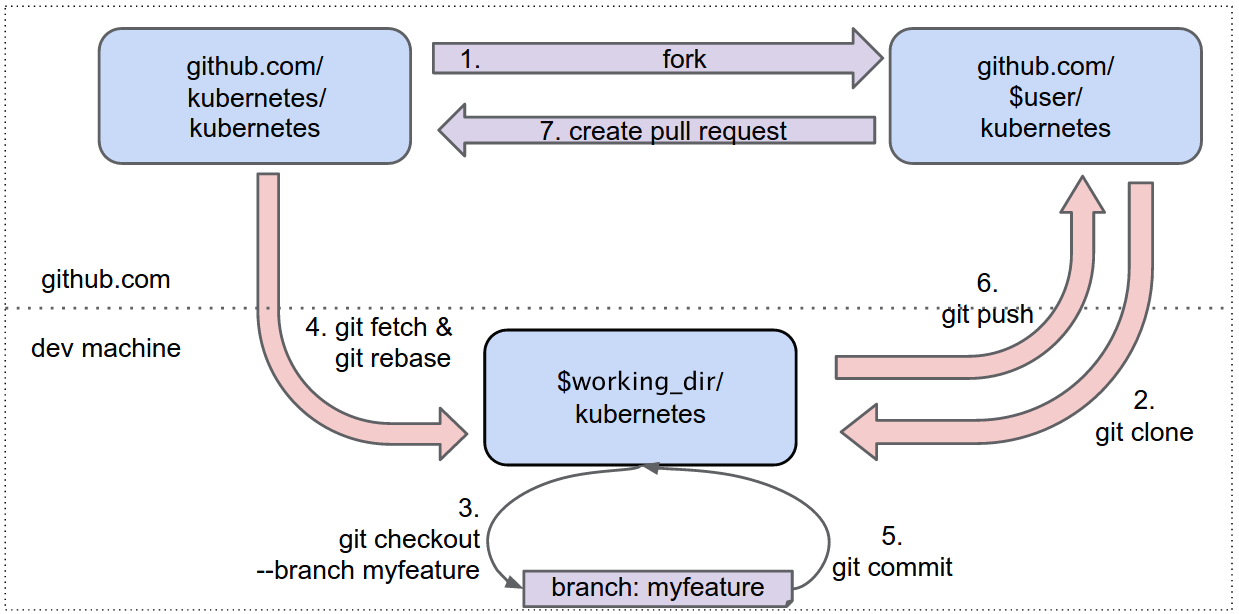
1 Fork in the cloud
- Visit https://github.com/kubernetes/kubernetes
- Click
Forkbutton (top right) to establish a cloud-based fork.
2 Clone fork to local storage
Per Go's [workspace instructions][go-workspace], place Kubernetes' code on your
GOPATH using the following cloning procedure.
Define a local working directory:
# If your GOPATH has multiple paths, pick
# just one and use it instead of $GOPATH here.
# You must follow exactly this pattern,
# neither `$GOPATH/src/github.com/${your github profile name/`
# nor any other pattern will work.
working_dir=$GOPATH/src/k8s.io
If you already do Go development on github, the
k8s.iodirectory will be a sibling to your existinggithub.comdirectory.
Set user to match your github profile name:
user={your github profile name}
Both $working_dir and $user are mentioned in the figure above.
Create your clone:
mkdir -p $working_dir
cd $working_dir
git clone https://github.com/$user/kubernetes.git
# or: git clone [email protected]:$user/kubernetes.git
cd $working_dir/kubernetes
git remote add upstream https://github.com/kubernetes/kubernetes.git
# or: git remote add upstream [email protected]:kubernetes/kubernetes.git
# Never push to upstream master
git remote set-url --push upstream no_push
# Confirm that your remotes make sense:
git remote -v
3 Branch
Get your local master up to date:
cd $working_dir/kubernetes
git fetch upstream
git checkout master
git rebase upstream/master
Branch from it:
git checkout -b myfeature
Then edit code on the myfeature branch.
Build
Note: If you are using CDPATH, you must either start it with a leading colon, or unset the variable. The make rules and scripts to build require the current directory to come first on the CD search path in order to properly navigate between directories.
cd $working_dir/kubernetes
make
To remove the limit on the number of errors the Go compiler reports (default limit is 10 errors):
make GOGCFLAGS="-e"
To build with optimizations disabled (enables use of source debug tools):
make GOGCFLAGS="-N -l"
To build binaries for all platforms:
make cross
Install etcd
hack/install-etcd.sh
Test
cd $working_dir/kubernetes
# Run all the presubmission verification. Then, run a specific update script (hack/update-*.sh)
# for each failed verification. For example:
# hack/update-gofmt.sh (to make sure all files are correctly formatted, usually needed when you add new files)
# hack/update-bazel.sh (to update bazel build related files, usually needed when you add or remove imports)
make verify
# Alternatively, run all update scripts to avoid fixing verification failures one by one.
make update
# Run every unit test
make test
# Run package tests verbosely
make test WHAT=./pkg/api/helper GOFLAGS=-v
# Run integration tests, requires etcd
# For more info, visit https://github.com/kubernetes/community/blob/master/contributors/devel/testing.md#integration-tests
make test-integration
# Run e2e tests by building test binaries, turn up a test cluster, run all tests, and tear the cluster down
# Equivalent to: go run hack/e2e.go -- -v --build --up --test --down
# Note: running all e2e tests takes a LONG time! To run specific e2e tests, visit:
# https://github.com/kubernetes/community/blob/master/contributors/devel/e2e-tests.md#building-kubernetes-and-running-the-tests
make test-e2e
See the testing guide and end-to-end tests for additional information and scenarios.
Run make help for additional information on these make targets.
4 Keep your branch in sync
# While on your myfeature branch
git fetch upstream
git rebase upstream/master
Please don't use git pull instead of the above fetch / rebase. git pull
does a merge, which leaves merge commits. These make the commit history messy
and violate the principle that commits ought to be individually understandable
and useful (see below). You can also consider changing your .git/config file via
git config branch.autoSetupRebase always to change the behavior of git pull.
5 Commit
Commit your changes.
git commit
Likely you go back and edit/build/test some more then commit --amend
in a few cycles.
6 Push
When ready to review (or just to establish an offsite backup or your work),
push your branch to your fork on github.com:
git push -f ${your_remote_name} myfeature
7 Create a pull request
- Visit your fork at https://github.com/$user/kubernetes
- Click the
Compare & Pull Requestbutton next to yourmyfeaturebranch. - Check out the pull request process for more details and advice.
If you have upstream write access, please refrain from using the GitHub UI for creating PRs, because GitHub will create the PR branch inside the main repository rather than inside your fork.
Get a code review
Once your pull request has been opened it will be assigned to one or more reviewers. Those reviewers will do a thorough code review, looking for correctness, bugs, opportunities for improvement, documentation and comments, and style.
Commit changes made in response to review comments to the same branch on your fork.
Very small PRs are easy to review. Very large PRs are very difficult to review. At the assigned reviewer's discretion, a PR may be switched to use Reviewable instead. Once a PR is switched to Reviewable, please ONLY send or reply to comments through Reviewable. Mixing code review tools can be very confusing.
Squash and Merge
Upon merge (by either you or your reviewer), all commits left on the review branch should represent meaningful milestones or units of work. Use commits to add clarity to the development and review process.
Before merging a PR, squash any fix review feedback, typo, merged, and rebased sorts of commits.
It is not imperative that every commit in a PR compile and pass tests independently, but it is worth striving for.
In particular, if you happened to have used git merge and have merge
commits, please squash those away: they do not meet the above test.
A nifty way to manage the commits in your PR is to do an interactive rebase, which will let you tell git what to do with every commit:
git fetch upstream
git rebase -i upstream/master
For mass automated fixups (e.g. automated doc formatting), use one or more commits for the changes to tooling and a final commit to apply the fixup en masse. This makes reviews easier.